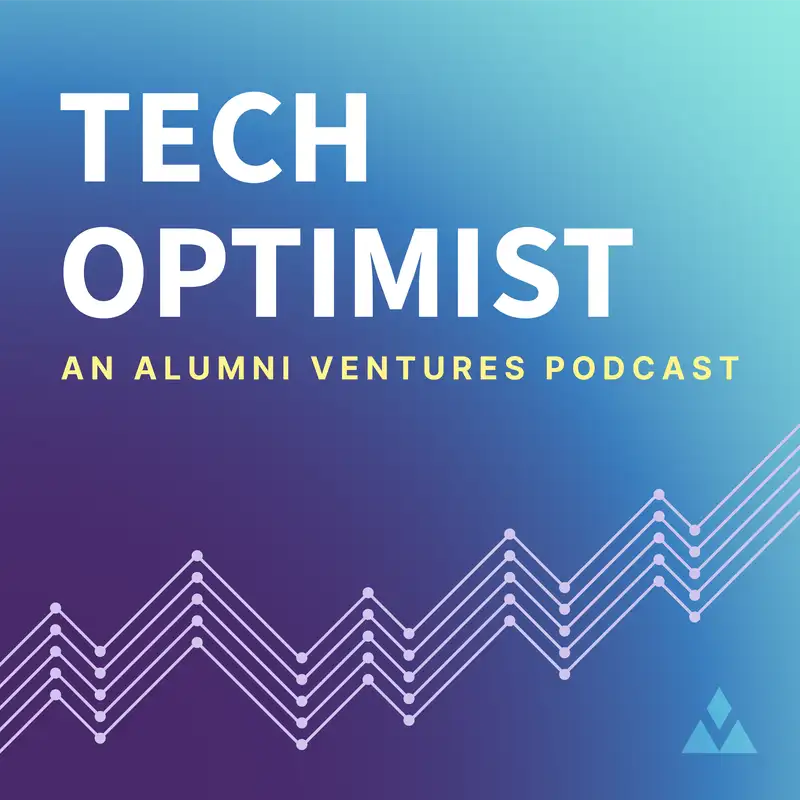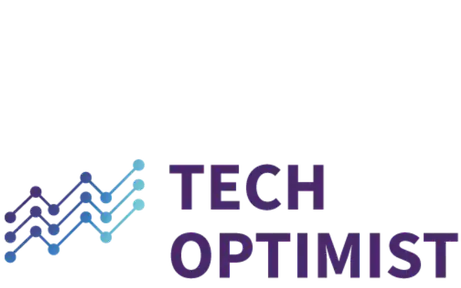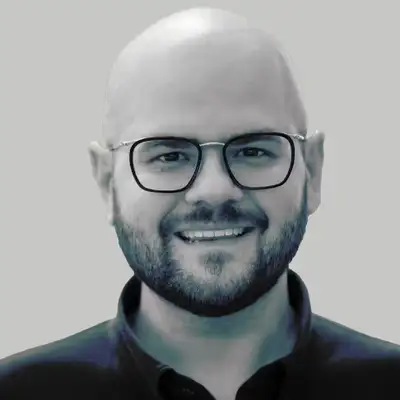#53 - Three Breakthroughs: Tech and Our Brains
Samantha Herrick:
A road that can charge your electric vehicle while you drive? All right, we got to hear this.
Mike Collins:
Innovation here, but we have to execute it and roll it out or it's basically going to be adopted by other countries who are going to be bolder in making these kinds of decisions.
Michael Peri:
If we're leading in the research, we should absolutely lead in the manufacturing and implementation of it.
Mike Collins:
And I think we need to continue to think even as these AI systems become geometrically more powerful and are able to do things, I still think we all want to think of them as tools for us.
Samantha Herrick:
Hello there. Welcome back to this episode of the Tech Optimist. This is episode 53, and it is another three breakthroughs episode for you guys. We got a cool one. I can't wait to dive into it with you. As always, our speakers for today are going to be Mike Collins, founder and CEO here at AV. And another AV member, Mike Peri, a partner here, is also going to be here with us in the episode today. And then you know my voice. My name is Sam. I'm the guide and editor for this show.
Let's dive into the meat of this episode. The topics that are discussed today are how some roads can charge electric cars as you drive on them, AI deep brain stimulation to treat Parkinson's, and high-tech surgery. Now, all three of these topics are so cool and I can't wait for you guys to hear them. I provided a few of my own tech notes here and there sprinkled in about some videos that I have found along with them, some articles that I have found.
Some of these videos include the head professor at Purdue literally talking on the highway about this road that they were experimenting on and building in person. As far as the deep brain stimulation, we talk about a skateboarder in San Francisco and how this treatment has helped him live his life a bit fuller.
And then in high-tech surgery, we talk about how it might be possible someday here in the future where a doctor could perform a surgery on the other side of the world using something that kind of looks like a PS5 or Xbox controller. Yeah, I know, it's crazy. All right, you're going to enjoy this one. Let's dive in. As a reminder, the Tech Optimist Podcast is for the informational purposes only.
It is not personalized advice, and it is not an offer to buy or sell securities. For additional important details, please see the text description accompanying this episode.
Mike Collins:
Hello, welcome to Alumni Ventures and our Tech Optimist Three Breakthroughs Podcast where we get together and talk about things in the news that have us super excited about the future. I'm Mike Collins. I'm the founder and CEO of Alumni Ventures, and I'm joined by Mike Peri, one of my partners out of our Chicago office. Hello, Mike.
Michael Peri:
Mike, thanks for having me.
Mike Collins:
Okay, so you're kicking off this week. What do you got?
Michael Peri:
Yeah, let's do it. Well, let's talk about a little bit of a journey here. So I want you to imagine a road that can charge your electrical vehicle as you drive. If I were to say that to you, do you think near-term, short-term, never going to happen? It's one of those where you're like, I don't know, maybe.
Mike Collins:
It would sound like that's in a lab somewhere and it's a maybe happen in five to 10 years. That would be my kind of...
Michael Peri:
A little bit further than in the lab. So the announcement or research has come out of Purdue University, great research institution, engineering school, and they have constructed the first highway segment in the United States that can wirelessly charge your electric vehicle while you're on the move. So I think it goes without saying, totally groundbreaking in and of itself.
But just this notion of being able to charge vehicles without the need for frequent stops or lengthy charging sessions, it not only re-imagines the consumer experience, but I also think it addresses a lot of the perceived obstacles we have where it's like, can you do electric long road trucking? So the potential of it, no doubt, if you can scale this would solve, I think in my mind, probably one of the biggest challenges facing EVs in...
Mike Collins:
Yeah, no, there is the perception that electric vehicles and there's stranded anxiety. Like, I'm going to get somewhere. There's not going to be a charging station. And oh, I've just grown up for 30 years and there's always a gas station.
Michael Peri:
You're hitting it on the head. In the article, they were like, it solves the biggest issue, range anxiety.
Mike Collins:
Range anxiety is the technical term. And again, a lot of us have become very accustomed now to charging with just setting our phones out on a coil or in our automobile there may be a place or there's a place at home where you can just drop your electronic devices and they get charged. We've talked a lot about areas of innovation, battery technology, EVs, transportation is obviously huge, driverless, charging. These things all are coming together, and I think they're coming together in the next decade.
Michael Peri:
And it's fascinating. For us as the investors, we see all these things that are step number one, the reimagined car, whatever type of transportation. What really caught my eye as it relates to this breakthrough is the notion of where that then crosswalks into infrastructure and manufacturing. So a little bit about how they think this could work. We can essentially design infrastructure on the highway to have coils embedded under the road surface, and then these coils will generate magnetic field.
You could put receivers in the vehicles, which then convert that energy into electricity. So for me, I was like, man, this is such a cool example of technologies then coming together to say, "Hey, here is not just the future of EV in general, but it's the future of manufacturing and construction in America where cars are going, how we're going to develop the highway systems." I live in Chicago. Mike, you know this, when you come in from O'Hare, you come on 90, you're like, this is a nightmare.
Perfect time to say they're redoing a lot of the bridges right now. Man, I would love if some of these bridges were able to charge my EV as I was driving. So just a very cool, I think, sci-fi type concept that we think about. But in the view here, much more closer to reality than we initially thought.
Mike Collins:
And I think here's one of the issues, which is these kinds of initiatives, driverless vehicles, these battery technologies recharging while you drive, require pretty bold moves. Our government systems aren't known to do that really well. So I think that this is also an area where like we have had in space some private test cases I think may be called for. We're seeing that with some high speed rail experimentation in the private sector, kind of a hybrid. I think it's a hybrid between Las Vegas and LA. I could see where this is another case where private industry picks a stretch of road.
Michael Peri:
Oh yeah.
Mike Collins:
Obviously, again, this would be something where you'd look for somebody that's really bold like Elon and Tesla because you've got to have the car compatible. I could see him doing a test section of highway paving it to prove it. Otherwise, what we're going to see is we're going to see something like this come out of...
They're going to take the technology and you're going to hear about it in China, or you're going to hear about it somewhere else. This is, again, where the future is is innovation here, but we have to execute it and roll it out, or it's basically going to be adopted by other countries who are going to be bolder in making these kinds of decisions.
Michael Peri:
If we're leading in the research, we should absolutely lead in the manufacturing and implementation of it.
Samantha Herrick:
Okay, everyone, it's Sam. I'm going to interject here really fast. So Purdue recently published a video with a few of the professors and a few of the students on this wireless EV charging road that they designed. I'm going to play the video here in a second, but it's the head professor who does most of the talking.
And then towards the end, if you're watching this video version, you can see a lot of the imagery of the technology in place on the road in a highway. So I wanted to share, it's really, really cool. He talks about some really fascinating stuff. So enjoy.
John Haddock:
John Haddock, I'm professor of civil engineering at Purdue University. We're on the side of a test project. It's a pilot project. It's a quarter mile long being built by the Indiana Department of Transportation. Technical name for it is dynamic wireless power transfer, which is sort of a fancy way of saying as you drive your vehicle down the pavement, it's able to charge the battery in your electric vehicle.
Why are we doing that? Well, so two of the big barriers to electric vehicle adoption, at least for the public, are range anxiety. Oh my gosh, where am I going to charge the battery on this car? And the second thing is cost, and a lot of that cost in electric vehicles is driven by the size of the battery packs that they have to have in order to get you that 250-300 mile range.
This system, you'd be able to drive your small vehicle down it and it would be able to charge the batteries you drive over the pavement at speed. So the speed limit here's only 55 miles an hour, but you could go even faster and it would charge the battery. What that allows us to do then is it means that now there's no range anxiety. You don't have to worry about where you recharge. The road's doing it for you as you drive.
Secondly, now you can have a smaller battery pack in your car that's going to reduce the weight of electric vehicles. It's also going to reduce the cost of electric vehicles. So you can see how it takes two of those high hurdles for electric vehicle adoption, kind of takes them out of play. This is one of a kind in the world that we're doing here because it's basically designed to be able to charge fully loaded semi-tractor trailers as they travel down the road at 65 miles an hour.
And that has never been done. So it's first of its kind. The way the system works is is that the coil in the road creates a magnetic field. And that as an electric vehicle with the receiver drives over that, as it crosses into that magnetic field, it's able to take an electrical charge from that field. So it works similar to the way you charge your cell phone at home when you lay it on that cell phone charger.
That cell phone charger sets up a magnetic field. You have a receiver in the back of your phone. When you put it on it, it's able to translate that magnetic field back into electricity and charge your battery. This works in basically that same manner. So currently, we're due to have the project finished next spring. So around May of next year, Purdue will actually take the project back from the contractor.
And when that happens, we'll start doing testing. Cummins, which is headquartered in Columbus, Indiana, they actually have a couple of electric semi-tractors that they've built. They're actually outfitting one of those to bring up here so that we can test the system using that semi-tractor. So that's what'll be next. We'll do the testing with the truck. We also have a trailer that has a receiver on it that we'll be able to pull over with a pickup and do testing.
What we would like to be able to do now is to test the system and try to begin to optimize it. What can we do to change it so that it becomes more efficient, we can make it so that it's less expensive, and things like that. Driving that towards the future, I think within the next three to five to seven years, hopefully INDOT's going to want to try and take this system and actually put it in an interstate for an actual trial in the real world.
Matt Caspari:
Hey, everyone, just taking a quick break so I can tell you about the Deep Tech Fund from Alumni Ventures. AV is one of the only VC firms focused on making venture capital accessible to individual investors like you. In fact, AV is one of the most active and best performing VCs in the U.S., and we co-invest alongside renowned lead investors.
With our Deep Tech Fund, you'll have the opportunity to invest in innovative solutions to major technical and scientific challenges, which can have a hugely positive effect on society, companies that have the potential to redefine industries and create a more sustainable future and deliver significant financial returns. So if you're interested, visit us at av.vc/funds/deeptech. Now back to the show.
Mike Collins:
Yep, good one. All right.
Michael Peri:
All right, what do you have?
Mike Collins:
So I think we're all familiar with the tragedy of Parkinson's disease, affected most of us directly or indirectly.
Michael Peri:
My grandmother suffered from it. Saw it firsthand.
Mike Collins:
Yeah, my dad had it. So it's something that definitely hits home. A lot of promising areas that we're working on in that space, there's even some clinical trials related to GLP-1 drugs, but one of the things they do now is they do deep brain stimulation, DBS. And the exciting new breakthrough is some work being done to use AI. And so it's really be calling adaptive or AI deep brain stimulation, ADBS, where basically the AI system is reading signals dynamically changing it, and it's much more adaptive.
So not only how effective it is, how it evolves, reducing the number of times you have to go back in and get the thing reset or retuned or adjusted in this progressive disease. Again, just a classic case of I think of something that's happening now, and in the very short term that that's going to be the standard of care for for this kind of approach.
I also think it touches on this bigger theme that we're talking about a lot, which is we're seeing incredible geometric growth in AI systems, machine learning systems, the power in your hand and in computer systems. And then we have the human brain, which is very old and biological and brilliant and creative and all these wonderful things. But the gap between it right now is here's my phone, here's my brain. I'm typing into it. I may be talking into it.
But we're starting to see more and more work being done to break down that interface. And I think we're seeing that with virtual reality, augmented reality goggles. I think we're seeing that from people working on implants into the brain. We have portfolio companies in that space. This is an area that is going to be a bottleneck, I think, which is how do we get this stuff even more tightly integrated with the human brain and the silicon brains and knowledge capacity out there.
Michael Peri:
No, that one's super cool. I mean, it's always been positioned as neurosciences, the next big frontier for us. If you draw parallels to exploring the frontiers, deep space, deep ocean, it's the ability to have transparent and fluid flow of data coming back to you or communication. I think what you're highlighting is that exact example here, the circuitry of the brain, relatively unknown. We've done an okay job.
But now if you meld a bit of that brain with AI circuitry and really understanding how it's evolving together, I think that frontier becomes reality very quickly. And these aren't just edge cases that are nice to have. I mean, these are truly transformational for humankind. I mean, it's super exciting to see that.
Mike Collins:
And it goes to conversations I think a lot of us are having every day of how do we think about AI and how do we think about technology as there's kind of the, oh, it's this other thing over here and it's going to act independently of me. I really try to encourage people to think of it as a tool, an augmentation, a way to make yourself better and more productive and do more cool things. And again, if you take a step back and you think about it, which is people today are AI augmented.
They are computer augmented. It is just a laptop or a desktop or a smartphone in their hand, but really in your hand you have the world's information, right? That's a huge augmentation to the human experience that has taken place in the last 20 years. And I think we need to continue to think even as these AI systems become geometrically more powerful and are able to do things, I still think we all want to think of them as tools for us that hopefully become more integrated with us as humans, but are helping us achieve what we want to achieve in ways that are beautiful and powerful.
And again, yesterday or day before, we had another announcement of product coming out of Apple Computer. They had their September product release with their new cool stuff. And I think one of the takeaways was the number of times AI was mentioned in the 90 minutes, and number two was the amount of energy they went in talking about silicon. And that these chips are in your phone, in your hand, they're GPUs.
The technology is just incredible that's in the palm of your hand or in your AirPods or in your watch. It's really about the custom silicon that's in those devices that are just right in your ear, on your wrist, in your hand. They have the goggles. That's about as close to the brain as you can get.
Michael Peri:
I was about to say, you're almost combining them.
Mike Collins:
You're really close kind of thing. But there's a very special barrier between the two right now, but they are right up to the edge on all these different fronts.
Michael Peri:
Yeah, no, very fascinating.
Mike Collins:
Cool.
Ludwig Schulze:
Hi, just a brief interruption to introduce you to the Healthtech Fund from Alumni Ventures. Alumni Ventures is one of the most active and best performing VCs in the U.S., and we have raised over $1 billion from more than 10,000 individual investors. With our Healthtech Fund, you'll have the opportunity to invest in a portfolio of around 20 healthtech startups, from transformative healthcare services to groundbreaking diagnostics. Our founders are paving the way for a healthier future. To learn more, visit us at av.vc/funds/healthtech.
Samantha Herrick:
Now, in August of this year, The New York Times published an article called A Personalized Brain Pacemaker for Parkinson's, written by Pam Bullock. And it's about this man who runs a skateboarding club out of San Francisco, his name is Shawn Connolly, and how he doesn't let the Parkinson's disease deter him from his life's mission and how this new development within DBS and AI machine learning has helped him live his life a bit better and a bit easier.
So there's a section of it that I want to read though. So deep brain stimulation has been used for years in Parkinson's. It's typically introduced when patients have achieved what benefit they can from medications containing levodopa, a drug that combats the deficit of the hormone dopamine that drives Parkinson's disease. Under conventional deep brain stimulation, patients receive a constant level of electrical pulses.
While it helps most patients, many eventually reach a plateau or, because a therapy does not adjust to a patient's experience, the stimulation may be too much or too little and lead to drastic swings between periods of rigidity and unbridled motion. "It's not like we've maximized, optimized, or finalized our abilities to treat Parkinson's patients," Dr. Sheth said.
In recent years, neuroscientists have identified brain signals that correspond to phases of stiffness, called bradykinesia, and phases of uncontrolled movement, called dyskinesia. In the new study, researchers use methods derived from AI to devise a personalized algorithm for each patient and a way to detect and respond to brain activity as the patient's systems have fluctuated.
"The brain changes in its needs moment to moment, hour to hour, week to week," said Dr. Philip Starr, a professor of neurological surgery at the University of California, San Francisco, and a senior author of the study who has worked on deep brain stimulation for decades. "It's been a dream to make these stimulators self-regulating." Dr. Simon Little, an associate professor of neurology at UCSF who led the study along with Dr. Starr, said that electrodes implemented in patients' brains recorded signals from populations of neurons, not individual brain cells.
"When neurons start synchronizing together, when they start all firing at the same time, they're like a crowd at a sports game," Dr. Little said, adding that in Parkinson's and some other disorders, neurons become excessively synchronized, with different patterns for different symptoms. "Some synchronization is good, but if you get over-synchronized, if your whole network starts chanting at the same time, then that's an unhealthy state because the brain is not really doing much information processing." All right, back into the show.
Mike Collins:
All right, what's your last one, Mike?
Michael Peri:
Okay. Sticking a little bit into the world of healthcare, so I saw a really fascinating article that basically approached this question of what if a surgeon could operate on a patient from the other side of the world? What's fascinating to me is the idea of remote surgery I think has been around for years, but recently in one of the first successful instances of this, a surgeon was able to successfully complete a surgery over 9,000 kilometers away from someone literally using robotic instruments controlled by the equivalent of a PlayStation 5 controller, which sounds incredible.
And I think in my mind I'm like, wow, have we really not been able to do that yet? But you think about the technology that's needed to do that at scale, I mean, it was blowing my mind how it was like advances in communication systems, ultra low latency, they're able to allow these surgeons to see real time images, control the surgical tools without any delay. So really it just demonstrates how moving forward this notion of telemedicine and a little bit of the AI view.
Telemedicine, robotic surgery, AI, that's the future of healthcare. These are going to be combined to provide healthcare to patients in the most remote or underserved regions or just literally allow some of the world's best physicians to be accessible to anyone worldwide.
Mike Collins:
And surgery is so high stakes and so requiring of... It's way up the skill specialization high stakes quadrant. So if you can do it there, in my mind, what a great ability for me to operate a crane remotely for a special job where I have special skills or special training a thousand miles away. So if we can do it there. Again, this whole idea of these new technologies are going to replace jobs and everybody's going to sit around writing poetry all day where I don't see that.
I really don't. I think we are always as humans pushing the envelope. And if you can do surgery there, you can do it in space. And if you can do surgery 9,000 kilometers away, you can do 900,000 kilometers just a day soon. So again, I just think it's a tell on what's going on. And again, these technologies come together, the goggles, the AI, robotics we talk about. There's nanotechnology just over the horizon.
But yeah, I think in the near term, the whole idea of telemedicine, I think we're starting to see it. I think we're starting to feel it. Definitely knocking out some of the earlier things. There's been a lot of surgeries. Intuitive surgical, we've talked about, has been a company round. There's other companies that are in this space right now, but I think it's one thing to do robotic aided surgery locally, it's another thing to set up pods to be where people are.
Samantha Herrick:
Okay, I'm going to butt in here really quick. I found a really awesome video from the BBC called The technology turning surgery virtual. Now, this isn't as insanely innovative as a surgeon operating on someone across the world using robotics, but this technology, developed by Dr. Nadine Hachach-Haram, pretty much allows any doctor to scrub into any surgery across the world. Now, it's, again, not as technologically advanced as the robotics surgery.
But if this type of operating system is developed and spread across the rest of the world, it gives it a better baseline for these other innovations with robotic surgery and AI surgery and AR surgery and all that crazy stuff to take place. So now this current system is being developed in hundreds of hospitals around the world, and the BBC did a really good video on it. So I'm going to share that now, and then we are going to finish off with the rest of the interview.
I thought it was really cool and I'm super excited to explain it. But the little intro description for this video says this, as a child in war-torn Lebanon, Dr. Nadine Hachach-Haram witnessed firsthand the devastating effect that inequality in surgical care could have. Today, 5 billion people across the globe still lack access to safe surgery. More people die from this than from HIV, malaria, and TB combined.
In response, she's created a technology that allows surgeons to virtually scrub into any operating theater around the world just by using a tablet or computer.
Dr. Nadine Hachach-Haram:
I think what's continuing to be clear is that we have such a fundamental challenge in surgery. Globally today, 5 billion people lack access to safe surgery. That's two-thirds of the world's population. And of that 5 billion, about 18.6 million people die every year from that lack of access. That's more than HIV, malaria, and TB combined. And so we need to do something about that.
And the current models of surgical care will never enable us to bridge that gap in the way that we need to. My name is Dr. Nadine Hachach-Haram. I created a technology that enables clinicians and clinical teams all around the world to virtually scrub in to any operating room or cath lab simply by using a phone, a tablet, or a computer. So my family and our heritage is Lebanon. During the war, my parents emigrated to the United States and we were born in California.
And at the age of about eight or nine, they felt it was really important for us to go back and connect with our family, our roots, and learn more about our culture. And so you can imagine leaving sunny California and landing in war-torn Beirut, just coming out and emerging of the civil war. Of course, as a young teenager, I'd seen quite a lot that many people perhaps my age hadn't seen.
But as a surgeon, those inequities continue to grate on me, those inequities that I'd seen as a child growing up. And it became clear to me that these inequities in surgical care were everywhere. So as a clinician, it was really important for me that whatever solution we design or build, really democratizes surgery as well, that it is not specific to a location or a piece of hardware that you can afford or a type of bandwidth that you have.
This software could be used in the most rural of environments, in a camp hospital in the middle of the field, in the middle of nowhere, to the most sophisticated teaching and training hospitals in the middle of a big city. Hi, Katie. How are you? Can you hear me?
Katie :
[Inaudible 00:33:31]
Dr. Nadine Hachach-Haram:
Yep, I can see that.
Katie :
So that's just being packed away.
Dr. Nadine Hachach-Haram:
So what you can see here is you've got a full view of the operating room, and that's the beauty of having multiple views. So imagine I'm sitting here, I can see all the views. I can control the cameras. I can zoom in and zoom out on what matters. I can expand a view specifically to the view that I'm interested in, and I can have a fully immersive discussion with the clinical team.
At the same time, on the left-hand side here, you have a number of annotation tools from simple pen illustration to a 3D hand to even the augmented reality hand, where this camera is capturing my hand movements in real time and overlaying them into the surgical view. And so in the operating room, they're able to see my hands as I interact with them.
So we've now zoomed into one of the views, the key view that Katie's now operating on. It's a difficult part of the operation, but I can now immerse myself in that case with her. So I can actually overlay my hand, which you can see on the screen, and I can gesture different movements, annotations, and she'll be able to see that on the screen where she is as well.
Dr. Amyn Haji:
Particularly for endoscopic surgery, which is natural orifice surgery, there are no cuts in the abdomen. There's no overview. So that three views and the ability to interact and annotate has been fantastic. You can actually just take your pen and draw on the screen and draw on it and say, "Well, okay, this is where you need to cut. This is what you need to do. This is what I'd recommend." So we've been using it in regularly in our practice and we continue to do so.
Dr. Nadine Hachach-Haram:
In 2019, I'd anticipated it would take about three to five years to really accelerate the adoption and growth of these solutions. But as COVID came, that change happened almost overnight. You can imagine healthcare workers who were self-isolating, who were unwell. Our workforce started to become depleted. And during COVID, we have a multitude of examples where this technology was the only solution available to enable us to deliver care to patients in some circumstances.
Dr. Amyn Haji:
I think the future is really exciting. With all the technologies coming together, we can actually collaborate more, not only as a local region, but as a country and across the world.
Dr. Nadine Hachach-Haram:
Whenever I think about the impact of technology, I'm not as interested in the technology stack as I am in the impact that it has to every single patient and the lives that we touch. This was a patient in her late 50s who unfortunately had suffered from multiple operations. She hadn't fared very well with that, ended up in intensive care for many months.
And so we were able to connect a global expert who does a lot of these cases through the technology dialing into this operating room. And four days later, she was home. That summer, she was at the beach in a swimsuit. And it has completely transformed her life to a person who no longer wanted to live, to now being able to live their best life. And that patient is my mother.
Michael Peri:
We're in such a awesome position and I would say privileged position at AV.
Mike Collins:
Yeah, privileged.
Michael Peri:
We have these very expansive portfolios where our team members are getting in the best robotics deals and at the same time, the best healthcare deals. This to me is the very easy way to describe it to any individual where it's like this breakthrough probably is more of a push in terms of where our communication systems have gone. So you start to think about some of these things we've invested in over the years, and you're like, oh, I didn't realize for ABC Communication Systems or different types of building ultra low latency, the ability for satellites to communicate with one another.
Maybe you thought early days, very defense related, other industry. Now, all of a sudden, you're like, oh no, it's robotic surgery miles away. It's just so cool to see all of these technologies coming together, which I think we'll only be able to see more of that, and that underpinning tends to be the power of compute. The power of AI is really bringing these different industries together.
Mike Collins:
And again, we talk a lot about space as a super exciting area where I think a lot of... There's arbitrage between people thinking of it as wacky space tourism stuff versus near term making real money. But there's an example of communication still has room to go. I mean, we should be able to do anywhere on earth high bandwidth communication, and we're not there yet.
It's getting better. I mean, you can be out pretty remote on hikes. You can get satellite coverage coming way, way down. So I think it's happening. I think it's going to just become like oxygen. I mean, it'll be one thing getting a text message in an airplane, it's another thing doing high-stakes surgery. But again, trends are all in the right direction. Very exciting and empowering for people.
It's liberating. It encourages freedom. There's political things that are super positive about worldwide communication access driving down costs for everybody.
Michael Peri:
Yeah, very cool. Awesome. Next week, see you again.
Mike Collins:
All right, see you. Bye.
Samantha Herrick:
Thanks again for tuning into the Tech Optimist. If you enjoyed this episode, we'd really appreciate it if you'd give us a rating on whichever podcast app you're using, and remember to subscribe to keep up with each episode. The Tech Optimist welcomes any questions, comments, or segment suggestions. So please email us at info@techoptimist.vc with any of those and be sure to visit our website at av.vc. As always, keep building.







